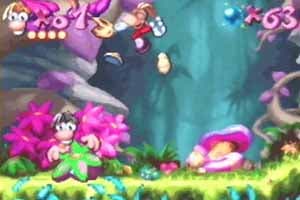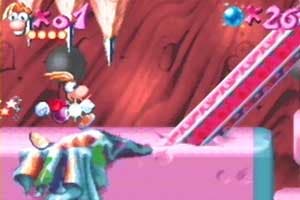Rayman Advance
Review - perky platform pretender Rayman waddles onto the GameBoy Advance

Pixel perfect?
What is it about the platform genre that keeps gamers coming back? Except perhaps for the real-time strategy game, there is no other genre where the relentless rehashing of ideas is rewarded so openly. Companies like Nintendo have made leaps forward with three dimensional platformers like Super Mario 64, but the fundamental task of bopping from platform to platform has remained a constant. The graphics may change, but the concepts do not. In terms of creativity, over the last ten years platform game designers have virtually stood still. Rayman Advance shamelessly continues this trend, but sadly takes the lethargic tendencies of platform designers one step further and simply ports the original PlayStation 2D platformer, almost pixel for pixel. As is usually the case, the storyline plays a distant secondary role to the game design. Rayman's arch-nemesis Mr. Dark has captured all the little inhabitants of Rayman's world and imprisoned the Protoons. Protoons are Rayman's source of power and as such you set off on a quest across some 6 worlds and 60 levels in order to rescue the captives. When you first start the game the state of play is linear, but deceptively so, with branching routes that all eventually lead to the same conclusion. Also, you soon learn that you are able to return to any level at any point during your quest once completed. The point being that you have to uncover every hidden cage of Protoons in every level before the game is 100% complete. During the course of the game a lot of the missions you partake of seem completely unbeatable, the reason being that developer Digital Eclipse decided to stagger the introduction of new power-ups across the whole game. These power-ups include the ability to punch, swing, hang from ledges and more. You can then go back to earlier levels and utilise these new skills to access previously unreachable areas, and by extension uncover more Protoon cages. It's all been done before of course, most notably in the Donkey Kong Country series and of course in the original PSX Rayman, but unlike its predecessor, the learning curve has been tweaked so that some levels are infuriatingly difficult.

Pretty as a picture
There's no mistaking the fact that Rayman Advance is a stunning looker, and possibly one of the best looking GBA games available at the moment. The areas you come to explore are pleasantly varied if a little oddball later on. Rich backgrounds woven together with several layers of smooth parallax scrolling complement the well-animated sprites as you progress from a jungle scenario through to bizarre worlds of musical instruments and stationary (sounds like my office - Ed). Rayman's off-the-wall locales are extremely reminiscent of classic madcap platformers like Earthworm Jim and James Pond. The game is a showcase of both the machine's palette and its ability to shift sprites. However, the development team has gotten a little overzealous in some areas, in particular when things get a little speedy and the screen begins to judder noticeably as it scrolls. Rayman's path through each level is frequently eventful, and you're almost never constrained to just running and jumping for an entire scene. Digital Eclipse have used all the tricks; power-ups, varying the pace, forcing players to clamber up steep slopes and hop to new heights. One level will see you planting seeds in the ground which grow to form platforms as you attempt to escape rising water (a la Rainbow Islands), whilst another sees you befriending a giant defeated mosquito and taking a high-speed journey through the forest on his back. While they're not all wholly original ideas, when cobbled together into one package it feels very complete. The size of Rayman Advance means that it fits its new host like a glove. It's not so tedious as to begin to bore dedicated players, yet it's just fun enough in short bursts to ensnare your attention. This is thanks, in part, to the game's on-cart save system which enforces a pick-up-and-play regime. Digital Eclipse decided not to plump for a password-based system, instead you are able to play the level of your choice and then hop across the world map to save your game at the end. This is especially useful as later levels can become so hugely frustrating that you'll often find yourself just switching off the GBA without thinking twice.
Conclusion
Though Rayman Advance makes admirable steps forward in a stale genre, it's essentially a mish-mash of same-old same-old with a new lick of paint. That we'll have true classics such as Sonic the Hedgehog appearing on the machine soon makes us wonder whether or not we need something like Rayman at all. Certainly it can satiate your desires for some simplistic jumping and climbing action, but it's all too easy to look past its cutesy, gimmicky charms and yearn for something more .. sophisticated.








